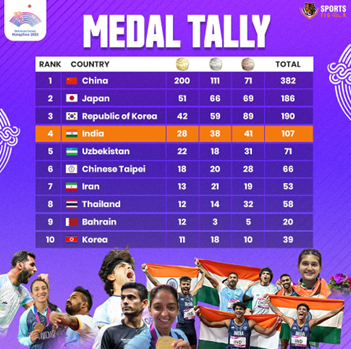Asian Games – Iss baar 100 paar
Relevance
- GS Paper 2 Important International institutions, agencies, and fora- their structure, mandate.
- Tags: #asiangames #medals #sports #currentaffairs #upsc.
Why in the News?
- India won a record 107 medals, including 28 gold, 38 silver, and 41 bronze at Asian Games 2022.
- India’s historic achievement at the Hangzhou Asian Games has sent the nation into a state of euphoria, overshadowing even the commencement of the Men’s Cricket World Cup.
- With a staggering total of 107 medals (28 gold, 38 silver, and 41 bronze), this marks India’s best-ever tally, surpassing the previous high of 70 secured at Jakarta 2018.
Diverse Excellence
- India’s remarkable success came from a diverse range of events, showcasing the nation’s increasing diversification of sporting excellence.
- While track and field (six gold), shooting (seven gold), and archery (five gold) contributed significantly to the medal count, podium finishes across 22 different sports highlighted India’s prowess in various disciplines.
- Impressive performances came from rowers, squash players, kabaddi stars, and the men’s hockey team.
- Additionally, there was a historic gold medal in equestrian and emerging heroes emerged in roller-skating, wind-surfing, wushu, and sepaktakraw.
- Even cricket, traditionally isolated from multi-disciplinary events, joined the celebration, securing two gold medals.
- Notably, India’s sports achievements are now amplified in this visual era, with unforgettable moments like Parul Chaudhary’s remarkable win in the women’s 5000m and Kishore Jena’s impressive performance in men’s Javelin, where he settled for a creditable silver despite leading Olympic and World Champion Neeraj Chopra.
The Value of Certain Medals
- In continental games, the value of medals can vary due to the level of competition in specific sports. Events such as badminton and table tennis in Asia boast near world-level competition, enhancing the prestige of medals won.
- Satwiksairaj Rankireddy and Chirag Shetty’s gold in men’s doubles badminton, H.S. Prannoy’s bronze in men’s singles badminton, and Sutirtha and Ayhika Mukherjee’s stunning win over the Chinese world champions in women’s doubles table tennis exemplify this.
The Global Perspective
- However, it’s essential to consider that only 12 out of the 28 gold medals are in events included in the Olympics roster.
- Even within these, only a few performances, like Neeraj’s remarkable 88.88m throw, are considered world-beating. This highlights the need for India to bridge the gap with global sporting standards.
Challenges Ahead
While India has made strides in improving its performance in the Asian Games, several challenges persist:
- Competition from Asian Powerhouses: India faces stiff competition from countries like China, Japan, and South Korea, which have well-established sporting systems and consistently excel in multiple sports.
- Lack of Consistency: Maintaining consistent performance across various editions of the Asian Games remains a challenge.
- Infrastructure Gaps: Despite improvements, India still lags behind in terms of sports infrastructure compared to some other nations.
- Bureaucratic Hurdles: Bureaucratic red tape can slow down administrative processes and hinder the development of sports in India.
Ways to Further Improve India’s Performance
- Investment in Sports Infrastructure: India must continue to invest in world-class sports infrastructure, including training facilities, stadiums, and academies. This will provide athletes with the resources they need to hone their skills.
- Sports Education and Grassroots Development: Identifying talent at a young age and nurturing it is crucial. Developing a robust grassroots sports program and school-level sports competitions can help unearth hidden gems and nurture them into future champions.
- Coaching and Sports Science: India should focus on developing a strong coaching and sports science ecosystem. Bringing in international coaches and sports scientists can provide Indian athletes with the best possible guidance and support.
- Government Support: Continued support from the government in terms of funding, policies, and incentives for athletes is essential. This will help alleviate financial burdens and motivate athletes to strive for excellence.
- Mental Conditioning and Sports Psychology: Training in mental conditioning and sports psychology is often overlooked but critical. Athletes should be mentally prepared to handle high-pressure situations and overcome challenges.
In conclusion, India’s performance in the Asian Games has been marked by moments of brilliance and room for improvement. By addressing the challenges and implementing the suggested improvements, India can aspire to be a formidable force in Asian sports, consistently competing at the highest level and bringing honor to the nation on the Asian Games stage.
|
Overview of Asian Games
|
India’s Historical Performance at Asian GAmes
| Year | Host Country | Total Medals | Gold | Silver | Bronze |
| 1951 | India | 51 | 15 | 16 | 20 |
| 1954 | Philippines | 37 | 10 | 8 | 19 |
| 1958 | Japan | 41 | 11 | 12 | 18 |
| 1962 | Indonesia | 39 | 10 | 10 | 19 |
| 1966 | Thailand | 35 | 7 | 8 | 20 |
| 1970 | Thailand | 28 | 5 | 7 | 16 |
| 1974 | Iran | 30 | 4 | 12 | 14 |
| 1978 | Thailand | 21 | 5 | 5 | 11 |
| 1982 | India | 57 | 13 | 19 | 25 |
| 1986 | South Korea | 37 | 5 | 9 | 23 |
| 1990 | China | 53 | 13 | 8 | 32 |
| 1994 | Japan | 32 | 4 | 3 | 25 |
| 1998 | Thailand | 59 | 7 | 11 | 41 |
| 2002 | South Korea | 35 | 11 | 12 | 12 |
| 2006 | Qatar | 53 | 10 | 17 | 26 |
| 2010 | China | 65 | 14 | 17 | 34 |
| 2014 | South Korea | 57 | 11 | 10 | 36 |
| 2018 | Indonesia | 69 | 15 | 24 | 30 |
Sources: The Hindu
Mains Question
“India’s performance at the Hangzhou Asian Games underscores the nation’s potential in various sports. Analyze the role of sports infrastructure, grassroots development, and government support in further enhancing India’s performance on the international stage. Also, discuss the importance of mental conditioning in sports.”





